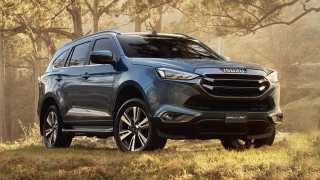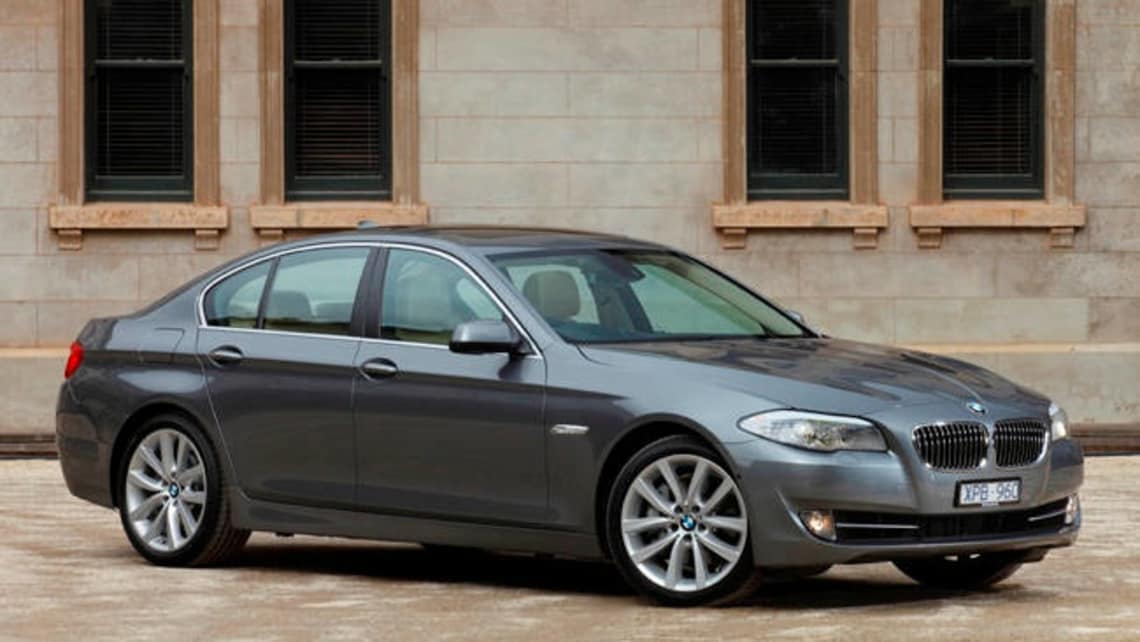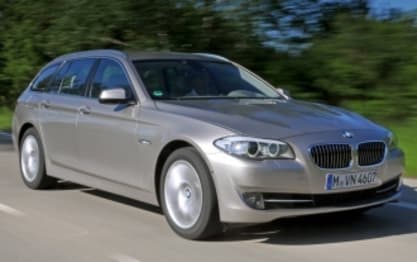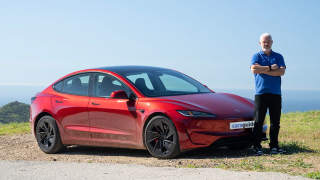
BMW 535i 2011 Review
- BMW 5 Series
- BMW 535i
- BMW 5 Series 2011
- BMW 535i 2011
- BMW 5 Series Reviews
- BMW 535i Reviews
- BMW Reviews
- BMW Sedan Range
- Sedan
- BMW
- Prestige & Luxury Cars
- European

FOR the man who designed it, the present BMW 5 Series marked a high point in his thinking about cars. He had taken BMW in a fresh direction and already shocked observers with his radical redrawing of the larger 7 Series sedan, then pushed the boundaries with the Z4 sports car. But the 5 that appeared seven years ago was cutting edge.
“The 5 Series uses a type of convex and concavity that no other car out there approaches,'' he said, referring to the signature curves of his style called flame surfacing. “If I was asked what is the most avant-garde car on the road right now, from any car-maker, I would say the 5 Series.''
That was four years ago and the designer, Chris Bangle, was visiting Australia to defend his approach. It needed defending because BMW's studio chief had been pilloried by brand loyalists everywhere for what he had done. They even went so far as to set up a website to vent their anger.
After more than a decade at the top, Bangle left the company a year ago and his designs are gradually being superseded. The 7 Series launched last year abandoned radicalism for something more conservative, while the latest Z4 evolves the previous design so that it is attractive, rather than challenging.
However, cars with some sort of flame surfacing are everywhere because those ideas, in some form or other, have influenced virtually every vehicle during the past decade. It's a moot point whether Bangle was the originator of this style or merely its high priest. Like other designers, car designers tend to move en masse in one direction.
However, sharp creases along the sides of cars and concave sections in doors, to cite two examples of the style, have become the everyday language of vehicle sheet metal. It's one reason, as its defenders point out, the Bangle 5 Series still looks modern. It's also the reason the new one, which goes on sale next month, has some recognisable Bangle ingredients, including a prominent crease along its flanks. In car design, the past decade's paradigm has yet to be replaced by anything else.
As with previous versions of the 5 Series -- this is the sixth generation -- the new one is a core BMW model that must work as a traditional family vehicle at one of the end of the line-up and as performance sedan at the other. Spy footage of the new M5, the go-fast version, is already circulating on the web.
In this respect, it has something in common with the Holden Commodores and Ford Falcons built here. And, like them, it's being usurped by the popularity of SUVs. BMW's large luxury off-roader, the X5, has outsold its sedan equivalent at least two to one every year here since it was launched. Despite the boom in the vehicle market and the way luxury imports have become increasingly better value, sales of the 5 have been flat.
The new one, which goes on sale next month, is unlikely to change that even though -- dollar for dollar -- it moves the bar up a notch on equipment, safety and efficiency over the present car. The trend towards SUVs appears unstoppable.
Unlike the Bangle car, this generation has few attention-grabbing ingredients and most of the technology has already appeared elsewhere. However, crucially, unlike the Bangle car, it delivers on the badge promise. This is no longer art for art's sake.
The price of being at the cutting edge was something that failed as a design on several levels. On the outside, Bangle's fancy curves generated some successful features -- the eagle-eye headlights, for example -- but the obsession with complex surfaces made the car appear bloated.
It also lacked overall coherence. The bonnet, cabin and rear could have been drawn by three different studios. The new car is bigger but doesn't look it. The surfaces are tauter and the proportions more harmonious. The droopy face of the Bangle car has been replaced by something more alert.
Inside, the Bangle 5 broke every rule in the BMW book. Chief among them was its abandonment of the cockpit-style thinking that had become a hallmark of BMW cabins, where the centre console is angled towards the driver. Instead, it alienated the driver with every dashboard surface sloping down and away. Thanks to this, some controls are difficult to operate and even the door handles are awkwardly positioned. BMW's rivals were cock-a-hoop.
Throw in the appalling first-generation iDrive control system, brittle plastics and an almost total absence of storage spots for a phone, wallet and so on, and it didn't matter how good the car was to drive. I hated being in the Bangle 5.
With the new car, it's back to business as usual. The materials are better, with pleasing aluminium highlights on the wood trim and more tactile plastics for buttons and knobs. The control locations make sense and are angled so the driver can see them. There are even a few places to stash stuff. Welcome home.
When BMW launched the latest 7 Series, it ditched iDrive version one and replaced it with something unrecognisable: version two. It is logical to use and owes nothing to its predecessor. It's in this car, of course.
On the launch drive early this month, only one model -- the 535i -- was available to sample but it could be the pick of the range. BMW has developed the 3.0-litre turbocharged straight six-cylinder engine that debuted a few years ago in the 335i, and combined fuel injection with turbocharging for the first time. The new unit ditches one of the two turbochargers and replaces it with a single twin-scroll turbo with two input streams from the engine's exhaust.
The result is a splendid powerplant that pulls strongly from low revs -- peak torque of 400Nm arrives at just 1200rpm -- for easygoing pace. It's also quiet most of the time, without the industrial soundtrack of some turbo engines, but when you lean on the throttle it emits a lovely, creamy snarl. There's an absence of lag or surge, two unwanted traits of turbo engines, and it steps off the mark respectably quickly to reach 100km/h in 6.1 seconds.
Adding the turbo 535i to the line-up means the range has been reorganised. The non-turbo 530i has been dropped, along with the smaller 2.5-litre six-cylinder engines in the 525i and 523i.
The entry-level six-cylinder is now the 528i, with a 190kW 3.0-litre straight six and a starting price just below $100,000. This looks like a good deal compared with the outgoing model. The only V8 is a 300kW turbocharged 4.4-litre in the 550i. BMW will offer a four-cylinder diesel later in the 520d and probably a six-cylinder 530d as well.
As well as better specification -- BMW's excellent head-up display is now standard, for example -- they all get a new eight-speed automatic transmission, which doesn't make a wrong move.
Underneath this car is the suspension from the 7 Series and the test examples were fitted with the full suite of BMW handling tricks, which include active dampers and active anti-roll bars, plus rear-wheel steering. With these (expensive) extras it feels tight and planted on the road, with typical BMW suppleness to the suspension.
It's a well-judged sporting drive experience for this category, without the rawness of smaller Beemers but with enough involvement when the roads tighten and twist. I suspect that even without the extras, that essential quality will be present. In addition, luxury and comfort levels are high. First impressions of the ride quality were very favourable, while road and tyre noise are well suppressed for good interior quietness.
If you don't go offroad then the new 5 should give you pause for thought. If you are shopping for a luxury family conveyance and can do without a high 'n' mighty driving position, then the new 5 is better to drive than its SUV equivalent and leaves you wanting nothing.
And I like this 5 a lot more than the Bangle car, which is all the better for not being a design statement. As the saying goes, I don't know much about art but I know what I like.
BMW 535i - $128,900
VEHICLE: Luxury sedan
ENGINE: 3.0-litre turbocharged straight six-cylinder
OUTPUTS: 225kW at 5800rpm and 400Nm at 1200rpm
TRANSMISSION: Eight-speed automatic, rear-wheel drive
Pricing guides
Range and Specs
| Vehicle | Specs | Price* | |
|---|---|---|---|
| 520d | 2.0L, Diesel, 8 SP AUTO | $12,760 – 17,050 | 2011 BMW 5 Series 2011 520d Pricing and Specs |
| 530d Gran Turismo | 3.0L, Diesel, 8 SP AUTO | $25,520 – 31,460 | 2011 BMW 5 Series 2011 530d Gran Turismo Pricing and Specs |
| 535i Touring | 3.0L, PULP, 8 SP AUTO | $21,450 – 27,170 | 2011 BMW 5 Series 2011 535i Touring Pricing and Specs |
| 535i Touring Sport | 3.0L, PULP, 8 SP AUTO | $22,770 – 28,160 | 2011 BMW 5 Series 2011 535i Touring Sport Pricing and Specs |
$13,400
Lowest price, based on 8 car listings in the last 6 months








